Features of flushing the heating system: an overview of the best ways
The gradual corrosion of metal on the inner surface of pipes and radiators in the heating circuit, the crystallization of salts in the coolant, leads to clogging of the heating system and a decrease in its overall efficiency.
To prevent this, regular flushing of the heating system with the removal of foreign particles from the heating circuit will help.
The content of the article:
Signs of poor heating
For normal functionality heating systems nothing should interfere with the movement of the coolant along the channels built for it.
There are several symptoms that a large amount of debris has accumulated inside the heating circuit, and scale has settled on the pipe walls. There are no obvious visual signs of clogging of the heating system.
It can be diagnosed with careful monitoring of the entire system and the appearance of a number of indirect signs:
- warming up the system takes longer than before (for autonomous heating systems);
- the operation of the boiler is accompanied by sounds uncharacteristic for it;
- increased consumption of gas or electricity;
the temperature in different parts of the radiators varies significantly; - radiators are noticeably cooler than the supply pipes.
However, weak or uneven heating of the batteries is not always a sign of clogging. May have happened them airing. In such a situation, it is enough to dump the air plug through crane Mayevsky.
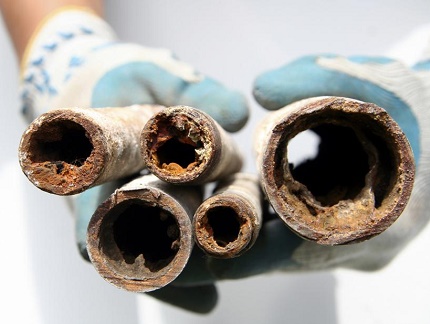
In houses with a central heating system, its flushing should be carried out by employees of the heat supply company. In a private house, this procedure is carried out by the owners or invited specialists.
It is difficult to recommend the frequency of flushing the system. Too many factors affect this.
So, for example, in central heating systems, the coolant must undergo a water treatment cycle, which reduces the degree of pollution. True, this rule is not always fulfilled. And the system itself is often operated for the third or fourth decade and the amount of garbage circulating inside increases every year.
But for both centralized networks and autonomous systemsIt is recommended to flush annually. Which, by the way, is confirmed by the requirements of building codes. It is this period that is considered critical for the accumulation of the amount of garbage inside the circuit, which significantly reduces the efficiency of work.
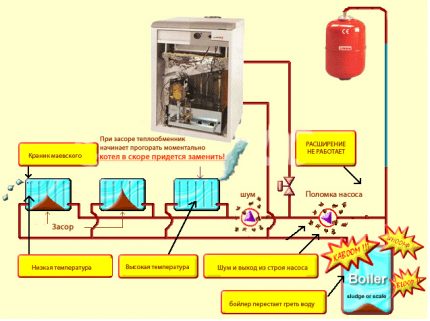
Heating system flushing options
Depending on the degree of clogging of the heating system, the volume and length of the circuits, several flushing options for heating systems can be implemented:
- mechanical;
- hydrochemical;
- hydrodynamic;
- hydropneumatic;
- electrohydropulse.
The first two methods do not require sophisticated equipment and can be carried out on their own without problems. The remaining methods involve an appropriate level of technical equipment performers. Therefore, for their implementation, you will either have to rent equipment, or invite specialists performing such work.
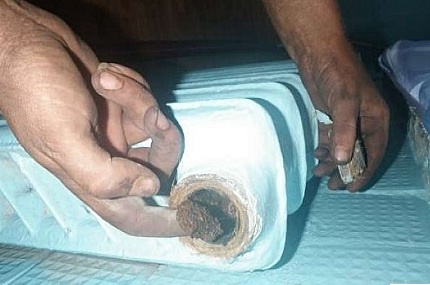
But in any case, there are certain rules for flushing autonomous or central heating systems, non-compliance with which will make the procedure ineffective. Next, we will talk in detail about each of the cleaning options so that the effect of the procedure is maximum.
Method # 1 - mechanical flushing
It is immediately worth noting that such a flushing is primarily aimed at cleaning radiators from accumulated dirt and, to a lesser extent, from scale on the inner surface of the circuit. Shut-off valves, expansion tank and circulation pumpIf it is mounted in the system, you will have to clean it separately.
Before starting flushing, make sure that coolant in the system, during the cleaning process, went out in a minimal amount. The procedure must begin with the overlap of the valves that limit the flow of coolant into the circuit.
If the procedure is carried out in a high-rise building, then the valves are usually located in the basement of the house. In a private house, valves are closed before and after the boiler.
The next step is to drain the coolant from the circuit. This can be done either through the drain valve, which was originally installed during the installation of the system. If there is no such tap, then the drain is performed by unscrewing the plugs on the radiator located below or further than all the others.
It is most convenient to discharge the coolant through a hose connected to a drain tap and discharged into a toilet or other plumbing fixture connected to the sewer. Mechanical cleaning will be more effective if you first remove the batteries and clean them separately. heating appliances and pipes.

The procedure for dismantling radiators from different materials does not differ in essence. But in any case, you should prepare a container for draining the remaining coolant. For the procedure itself, you will need keys of the appropriate size. To unify the process, it will be useful to have a pipe wrench in the arsenal - the “ass”.
Depending on which radiators connected to the circuit, and the dismantling procedure is different. In any case, the radiator has an input and output for the coolant. In the process of dismantling, we release cape nuts connecting radiators with pipes. At the first one or two turns of the nut, you need to be prepared for the fact that the rest of the water starts to ooze from the connection. We collect it with a rag.
After the tightness of the untwisted joint "radiator pipe»Increases, the collection of the flowing coolant is carried out in a container - a basin, a trough or something similar. At the same time, we carefully monitor that the coolant does not leak to the lower floor.
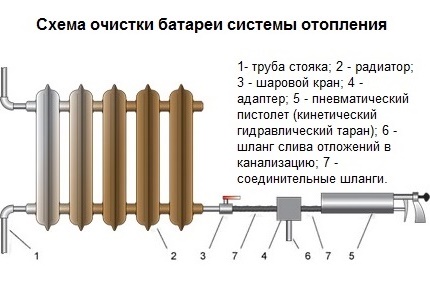
After dismantling the radiator, we take it out either to the courtyard or to the bathroom. At the same time, we cover the plumbing from damage to the enamel coating with a dense fabric, which then is not a pity to throw away. Sink drain or bathtubs must be covered with a net to prevent clogging of the siphon and sewer.
Mechanical cleaning of the radiator can be done with a cable similar to the one used to clean the sewer. We carry out the same procedure with pipelines. However, for a network with many turns, mechanical flushing will be difficult.
After the cleaning of the batteries and pipelines is completed, we proceed to rinse them with water. We wash the radiators in the same place in the bathtub or in the yard, directing inward a stream of water from the hose.
For flushing pipes, it is more convenient to use hoses with adapters. They allow hermetically docking hoses for supplying water to the heating circuit and for draining it into the sewer. Flushing the heating system with water is performed until it becomes clean at the outlet.

After flushing the radiators and pipes, you can repeat the mechanical cleaning procedure. To make the procedure more effective, it is better to introduce the cable in the direction opposite to the direction of movement of the coolant.
This is done so that the "scales" settled in the direction of movement are torn off as a result of mechanical contact. If there is less dirt in the flowing water than in the first round of cleaning, then the procedure is effective.
Method # 2 - hydrodynamic cleaning
When choosing this method of cleaning systems, the procedure will require the availability of special equipment.Water in this case is supplied not from the tap using a regular hose, but from a pump under high pressure.
Sometimes during hydrodynamic flushing, the pump is connected to the gap of the heating circuit as far as possible from the point of discharge of dirty water. But more often a special hose with trailer.
The design of the end nozzle has holes of small diameter. High pressure water flows through them.
It is the accented effect of water jets supplied under pressure that makes it possible to effectively combat mud and salt deposits. The supply hose can be specially stopped in potentially problematic places for more effective washing.
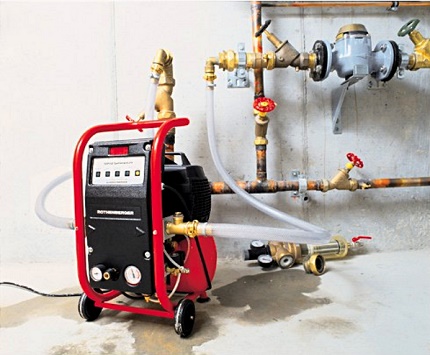
Choosing a hose for hydrodynamic flushing, it must be borne in mind that with sufficient rigidity, you can apply pressure further from the inlet. True, it is problematic to move such a hose on the bends of the heating system pipes.
Therefore, when conducting a hydrodynamic flushing using a hose, it is necessary to open the heating circuit in several places in order to supply water to all points.
Method # 3 - chemical flushing system
Flushing can also be performed without mechanical intervention. For these purposes, there are either ready-made chemical compounds or solutions that are easy to prepare at home. The dismantling of heating radiators is not required.
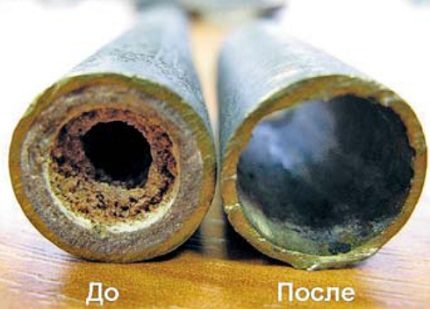
The disadvantage of chemical washing is the prohibition of the use of aluminum radiators for washing and in a large number of caustic solutions that require disposal in specially designated places.
If the heating circuit is not very clogged, then for its preventive washing it is quite possible to use:
- caustic soda;
- vinegar;
- available acids (phosphoric, phosphoric and others);
- whey and others.
But it is better to use specially designed formulations for these purposes. Their packaging will not only indicate the recommended use case (pipe material, the nature of the pollution, etc.), but also detailed instructions for use.
Orientation to the instructions will allow not only the most efficient use of the composition, but also with the lowest cost to clean the heating system.
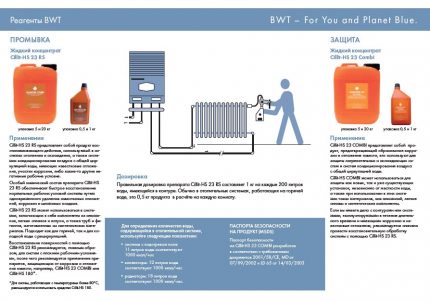
It is recommended to withstand the time intervals of the action of reagents as accurately as possible. At the same time, in autonomous systems, do not forget to turn on the circulation pump to ensure even distribution of the "activated" coolant.
For carrying out this type of flushing, it is useful to have a pump with a capacity at its disposal - a booster. In order to connect it to the system, it is necessary to organize a gap in the circuit. You can, for example, do this by disconnecting the direct path from the boiler to the heating circuit. Also, a tap must be provided in the circuit to discharge used reagent.
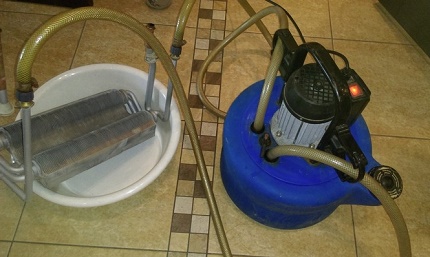
In order to ensure uniform scale destruction on pipes and radiators, after reagent injection we leave it in the system for a period of several hours to several days.The main disadvantage of this cleaning method is the possible negative effect of the active substance on the pipe surface. Therefore, after processing the system, we rinse it with clean water.
A more gentle, but similar in action, method of cleaning the heating system pipes from overgrowing is dispersed cleaning.
In this case, a reagent is introduced into the system, acting solely on settled particles. In this case, the metal remains without a negative impact. And the procedure itself is similar to chemical cleaning.
Method # 4 - hydropneumatic cleaning
One of the most effective and equipment-friendly cleaning options heating systems from accumulated dirt is considered flushing the heating system hydropneumatic method. Its essence lies in the supply of high-pressure air into the heating circuit.
Air is supplied to the circuit by a compressor. In this case, turbulent flows with high kinetic energy are created inside the pipelines. Due to this, there is a breakdown of growths from the inner surface and leaching of accumulated dirt from radiators.
Turbulent flows along the heating circuit are not continuous, but from time to time in the form of short-term impulses. Create such pulses using air gun. The compressor is connected to the circuit through a check valve. This will prevent water from entering the compressor.
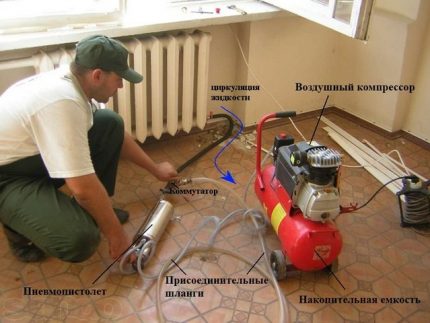
For washing, we block the flow of coolant into the circuit. Then we connect the compressor with air gun. If flushing is performed without dismantling the radiators, then at the farthest radiator we unscrew the plug and connect the hose through the adapter to dump the garbage and put it in the toilet.
The first air supply to the system should be done in the direction opposite to the circulation of the coolant.The second procedure can be performed by changing direction (swapping hoses for supplying pressure and dumping debris).
Can hydropneumatic flush with the dismantling of radiators. It will be more troublesome, but also more effective. Then the batteries are best taken outside and rinsed there.
After the flushing procedure put radiators in place, connect the circuit to the boiler and put it into the coolant pipeline. Those debris that is in the system will be washed with water.
Then briefly block the flow of coolant, undock drain hose and put the plug back in place. Now you can start the system in work.
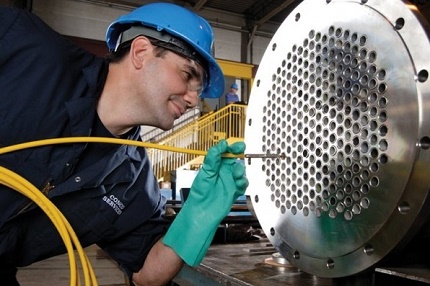
Method # 5 - electrohydropulse methodology
The basis of this flushing method is the use of electric pulse energy, which is aimed at the destruction of salts deposited on the walls of pipelines. It is effective precisely for such control of such clogging of heating systems. The pipes themselves are not exposed to this effect.
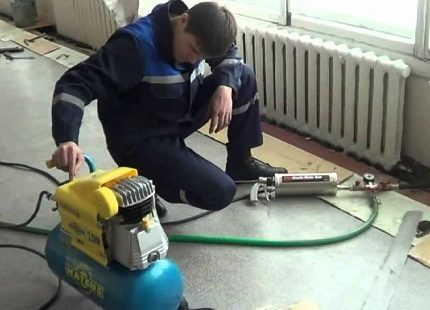
A special apparatus is used to generate an electrical impulse. A coaxial cable is connected to it, at the opposite end of which a discharge is formed, the shock wave from which destroys the scale on the inner surface.
After that, the system is washed with clean water to remove foreign particles separated from the surfaces.
Carrying out a system cleaning by the electric-pulse cleaning method requires special equipment. But its effectiveness is great enough and there is no need to disassemble the system for flushing. Moreover, unlike chemical cleaning, all slag can be drained without hesitation into the sewer.
Conclusions and useful video on the topic
Video # 1. Application efficiency hydropneumatic radiator flushing can be estimated by the amount of dirt thrown out:
Video # 2. The subtleties of performing a chemical type of washing the heating system are described in the following plot provided by the owner of a private home ownership:
Any of the options for flushing heating systems are not too complicated. If you have some experience in plumbing and, in some cases, special equipment that can be rented, you can do this yourself.
Do you want to ask a question about the effectiveness of flushing or tell us how to flush the heating circuit in your home? Are there any valuable recommendations or important nuances that you want to share with site visitors? Please write comments in the block form below.

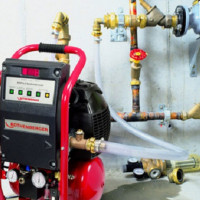 Flushing gas heating systems: flushing methods and procedure
Flushing gas heating systems: flushing methods and procedure 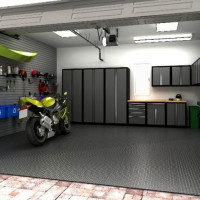 How to better organize garage heating: a comparative overview of the best ways
How to better organize garage heating: a comparative overview of the best ways 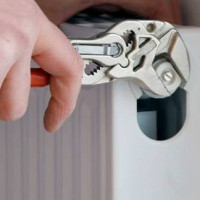 Removing air from the heating system: how to bleed air
Removing air from the heating system: how to bleed air 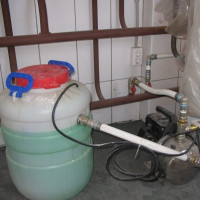 Filling the heating system with coolant: how to fill with water or antifreeze
Filling the heating system with coolant: how to fill with water or antifreeze 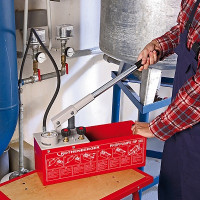 How to pressure test a heating system with your own hands
How to pressure test a heating system with your own hands  Insulation for heating pipes: overview of types + application examples
Insulation for heating pipes: overview of types + application examples  How much does it cost to connect gas to a private house: the price of organizing gas supply
How much does it cost to connect gas to a private house: the price of organizing gas supply  The best washing machines with dryer: model rating and customer tips
The best washing machines with dryer: model rating and customer tips  What is the color temperature of light and the nuances of choosing the temperature of the lamps to suit your needs
What is the color temperature of light and the nuances of choosing the temperature of the lamps to suit your needs  Replacement of a geyser in an apartment: replacement paperwork + basic norms and requirements
Replacement of a geyser in an apartment: replacement paperwork + basic norms and requirements
The batteries have not been cleaned for more than 5 years and somehow did not think about it. Apparently, the employees of the heat supply organization are not aware of such events. Have to clean yourself.I did not find a description of the hydrochemical treatment; there is simply a chemical one. Apparently this is a reagent + cable. And if there is no pump, can you just pour the reagent into the radiator for a while, then clean it with a cable, and rinse at the end with water pressure? Or it won’t help, still 5 years, and maybe more (5 years only we live in an apartment!). And nobody cleared anything.
Chemistry is divorced with water and poured into the system. Then the water is heated to the maximum degree and at this moment it drains from the heating circuit. Then the entire system is washed, clean water is poured into the system and pressure testing is carried out.
If you still have metal pipes installed, I advise you to replace them with plastic ones. In them, plaque will not grow as fast as it does in metal pipes. After a change in the law, utilities are not responsible for maintaining the radiators in apartment buildings in good condition.
From personal experience I can recommend a chemical way to clean the heating system and radiators. Just hire a specialist for this, and not do it yourself. A qualified worker will do everything necessary in one day, while modern solutions allow you to perform this procedure without any negative consequences.
If you change pipes to plastic, then you can clean the radiators from scale and deposits yourself.
I work for a company that sells home-safe and easy-to-use solutions and concentrates for flushing heating systems and removing rust, scale and deposits. After using the products we have proposed, repeated flushing with additional chemicals is not required. reagents that are specifically designed for various materials.
Please give contacts or a link to the company.
Is the chemical method suitable for a private house or is it just for urban apartments? Recently, problems with circulation in the system have begun - the top of the battery is hot, the bottom is a little warm.
Hello. Yes, of course it does. Only entrusting this is best to specialists.
Please note that such symptoms may also indicate air entering the system, problems with shutoff valves, lower pressure in the line, poor circulation of the coolant, cold in the room in which the problematic radiators are located.